If Spanish isn’t your first language – and you love coffee – then this is the guide you’re looking for. You’ll learn 13 ways to order coffee in Spanish. Plus popular coffee drinks, common expressions and required coffee vocabulary.
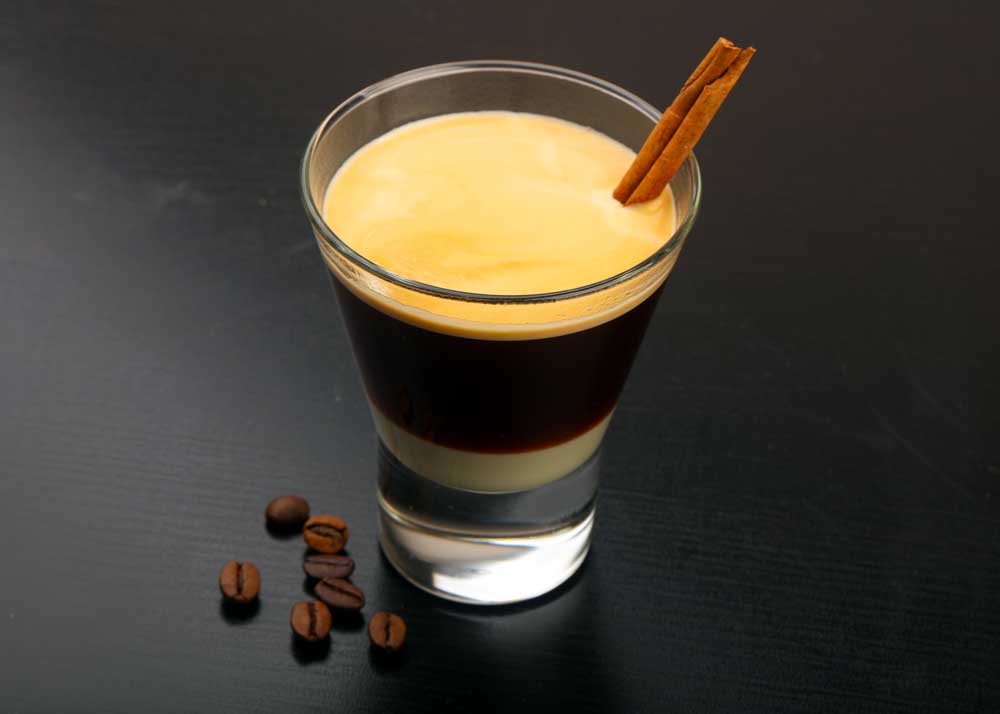
Guide to Coffee in Spanish
Something I’ve learned from my time in South America is how to order a coffee. I’ve ordered hundreds of cups of coffee at cafes and restaurants in Ecuador, the Galapagos, and Venezuela, and even a few on Calle Ocho in Miami’s Little Havana.
In this post, I’ll share with you what I’ve learned – so you can comfortably order a great cup of coffee.
Get the cheat sheet: How to Order Coffee in Spanish: Cheat Sheet. It’s downloadable (and printable). And will put all these phrases in your pocket.
“Can I have a coffee please?” in Spanish
This is the simplest way to order a coffee in Spanish.
- Un café, por favor. (Neutral – neither formal nor informal) In English, this is: “A coffee, please”.
- ¿Me das un café, por favor? (informal)
- ¿Me da un café, por favor? (formal)
Something to know about Spanish is that there are two ways to say most things: formal and informal. While you can get away with informal in most settings, you won’t go wrong with the formal expression. I have included both in most of these expressions.
Spanish word for coffee
The word for coffee in Spanish is café. It is pronounced as (kah-feh).
Coffee in Spanish is el café (m).
How to say coffee in Spanish
Coffee in Spanish is café and it is pronounced as (kah-feh).
Something else to know about Spanish is that the nouns have gender – either masculine or feminine.
In the case of coffee, it is a masculine noun. This means that cafe uses the masculine article “el”. In contrast, leche (milk) is feminine so it uses the feminine article “la”.
So here’s how it looks:
- The coffee = el café
- The milk = la leche
How to spell coffee in Spanish
Coffee is spelled the same ways as we spell cafe – another word for a coffee shop: c-a-f-é
But as you have probably noticed, the Spanish word café has an accent over the “e”. This accent (é) is called an acute accent. It is used to indicate word stress, that is, which syllable to emphasize when speaking. Here’s more about Spanish accent marks.
What is coffee shop in Spanish?
To keep things simple, the word for coffee shop and coffee is the same: café. Also, the same word is also used for the color brown.
Here are the three meanings of the Spanish word “café”
- Coffee drink: café
- Coffee shop: café
- Color brown: café
So, just to keep things clear, here’s how these all come together:
“Tomé un café en la café de color café del centro.” (In English: I drank a coffee in the brown coffee shop downtown.)
So, how do you say cafe (coffee shop) in Spanish? The same way as you say coffee: café.
“Would you like coffee?” in Spanish
- ¿Quieres una taza de café? (informal)
- ¿Quiere una taza de café? (formal)
“More coffee” in Spanish
- Más café. (More coffee)
- Más café, por favor. (More coffee, please)
- Necesito más café. (I need more coffee)
Who doesn’t, right? This is helpful when asking your waiter to refill your mug.
Years ago, my daughter bought me a mug while we living in Ecuador. It traveled back to Canada with us. And it says “I need coffee” in Spanish (Necesito café).
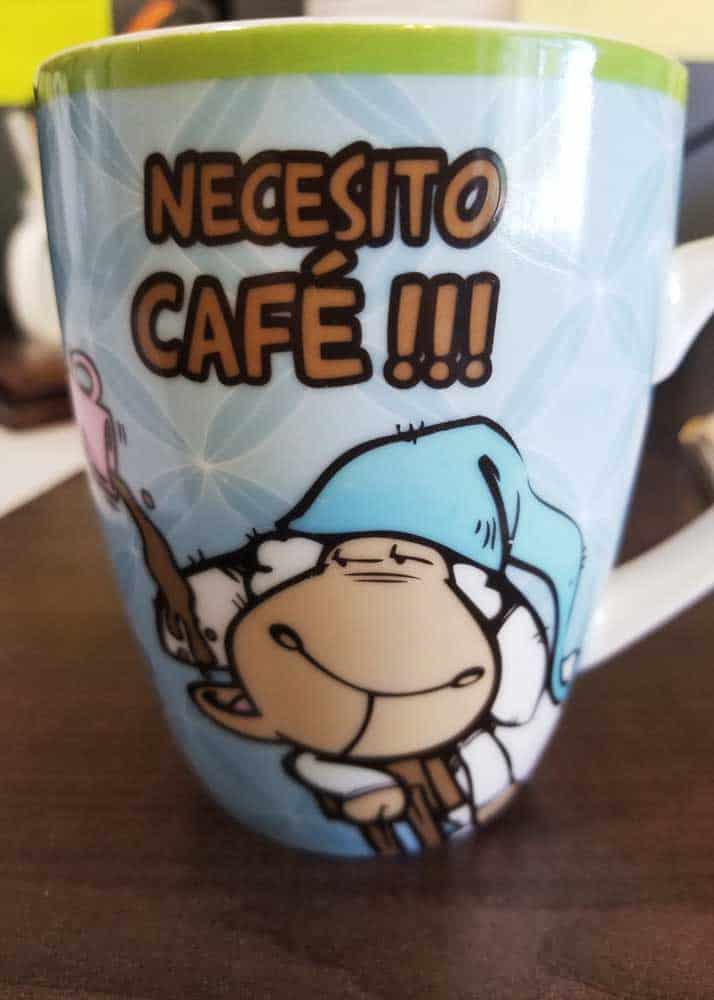
How to Place Your Coffee Order
Here is how a typical conversation might play out.
- ¿Qué vas a tomar? (Barista)
- Un momento, por favor. (Just a minute, please) You, if you need more time.
- Estoy viendo. Estoy decidiendo. (I’m looking. I’m deciding)
- Voy a querer un… (I would like to order…) Just insert the name of the drink you would like.
Common Spanish Names for Coffees
Here is a brief summary of some common coffee drinks. For more detail, see the section at the end of the post.
- Café solo / Espresso: Café solo is basically an espresso shot. It literally means “just coffee”. It comes black and strong. There won’t be any milk or sweetener added.
- Café Americano: This is basically a watered-down espresso. But don’t be deterred. A well-made Americano can be very satisfying. This is the closest you might find to a coffee from the United States or Canada. Here’s how it compares: Americano vs Brewed Coffee.
- Café con Leche: Also known as latte / lechero.
I recommend starting with the basics. Try ordering a simple drink above. As you get more comfortable, maybe expand to try ordering some of the fancier drinks listed below.
How Spanish Coffee Shops Work
Depending on where you are visiting, you might order a coffee drink that comes premixed with milk and sugar. But in other areas, you’ll get a black coffee and then mix it yourself.
Before ordering, just stand back for a minute and watch how the process works. Is there a separate station for customers to add milk and sweeteners? Or does the barista make a complete coffee for each guest?
Not only does this vary between countries, but it can also vary with cafes across the street from each other.
If you need to clarify the mix, here are the basics for milk and sweeteners.
Milk in Coffee
Here are the Spanish expressions with English equivalents.
- ¿Con leche? With milk? (Barista)
- Si, con un poco de leche = Yes, with a little milk. (You)
- No, sin leche = No, without milk. (You)
There are a few types of milk that might be available, especially in the larger centers.
- leche de vaca (cows milk)
- leche de almendra (almond milk)
- leche de soya (soy milk)
- leche de coco (coconut milk)
Sugar in Coffee
- ¿Con azucar? With sugar?
- Si, con un poco de azucar. = Yes, with a little sugar.
- No, sin azucar. = No, without sugar.
Ice and Alcohol in Coffee
- Con hielo. With ice
- Con alcohol (ron, whisky, brandy). With alcohol (rum, whiskey, brandy)
“To drink coffee” in Spanish
There are two verbs to say “to drink”: beber and tomar.
- tomar (toh-MAHR): to take, to consume. It can also mean, to take, to have, to get.
- beber (beh-BEHR): to take, to drink.
The verb you’ll use depends on where in the world you are. To some Spanish speakers, these verbs are used interchangeably. Other areas use only one or the other.
- Tomar café: to drink coffee. In a sentence: Me gusta tomar café. (In English: I like to drink coffee.)
- Beber café: to drink coffee. In a sentence, although less common: Me gusta beber café. (In English: I like to drink coffee.)
From my experience, tomar café is commonly used in Latin America – at least commonly understood. Beber café might be more commonly used in Spain.
“Coffee with milk” in Spanish
Café con leche: This is as simple as it sounds. Your coffee comes mixed with steamed milk.

Ordering Coffee in Spain
What is in Spanish coffee? As the following list details, the drinks are fairly basic. They all include an espresso shot. Some other ingredients include milk (steamed or sweetened condensed), honey, spices, ice, or alcohol.
13 Spanish Coffee Drinks
Here is a full list of the types of coffee you can try in Spain. They range from no milk to a more milk than coffee. The English translation is noted in brackets for each type of Spanish coffee.
- Café Con Leche: (Coffee with milk) Served with equal parts espresso and milk. You might be given the option of hot, cold, or lukewarm milk. Because the milk is steamed first, ordering hot milk will be faster because it won’t need to cool before they can serve it with your coffee.
- Café Americano: (American coffee) Rich flavor but more water than an espresso. Basically, it is an espresso that has been watered down to be the same strength as a regular “American” coffee.
- Café Solo: (Just coffee) This is an espresso shot. Served black and strong.
- Descafeinado: (Decaf) Decaf coffee just hasn’t really caught on in the Spanish-speaking world, at least not as it has in the United States or Canada. Even in the English-speaking world, decaf is the focus of many coffee jokes.
- Café Cortado: (Cut coffee) The Spanish word cortado means “cut”. It refers to espresso with a touch of steamed milk. It is also known as espresso macchiato (or caffè macchiato in Italy). Sometimes called manchado.
- Café con Hielo: (Coffee with ice) Popular type of coffee on hot, summer days. Basically the Spanish version of iced coffee. It is served as a hot cup of coffee with another cup of ice cubes.
- Leche Manchada: (Stained milk) This is the opposite of cortado – and consists of warm milk “stained” with a touch of coffee. This is a popular option in the afternoons/evenings when someone might not want a full-strength coffee.
- Café Bombón: (Sweet coffee) This is an espresso shot with condensed milk. The ratio is 50/50 of coffee and sweetened condensed milk. And these two ingredients remain as separate layers until you mix them to blend the flavors. These sweet coffee drinks come from the Canary Islands. Also known as cafe canario. There is a version with liquor known as barraquito.
- Carajillo: (Coffee with a splash of liquor) This is a standard espresso shot with a dash of alcohol. It might include rum, brandy, or whiskey. But no milk in this coffee drink. The province of Castellón has a local variation of this drink. Carajillo de Castellón is similar but also features sugar, lemon rind, coffee beans, and sometimes cinnamon sticks.
- Café Belmonte: (Coffee with condensed milk and brandy) This drink is a mix of café bombón and carajillo. Take an espresso shot, add sweetened condensed milk, and a splay of brandy. Originally from Murcia, Spain. A variation is Trifásico or tricolor that comes from the Catalonia region of Spain.
- Blanco y Negro: (White and Black) Espresso mixed with ice. Topped with ice cream or leche merengada (milkshake).
- Café del Tiempo: (Weather Coffee) This is an iced coffee similar to café con hielo. But it may also be mixed in any number of variations above. Basically, any of the above Spanish coffees can become café del tiempo by adding ice. This makes any of these drinks perfect for the heat of the summer. Temperature is not cold – just room temperature.
- Café con Miel: (Coffee with honey) This is one of my favorite ways to drink coffee – with honey. This drink consists of an espresso shot, honey (miel), and steamed milk. Honey is used as a replacement for sugar. Other spices (like cinnamon, vanilla, ginger, or cardamom) may also be added. Read more about putting honey in coffee.
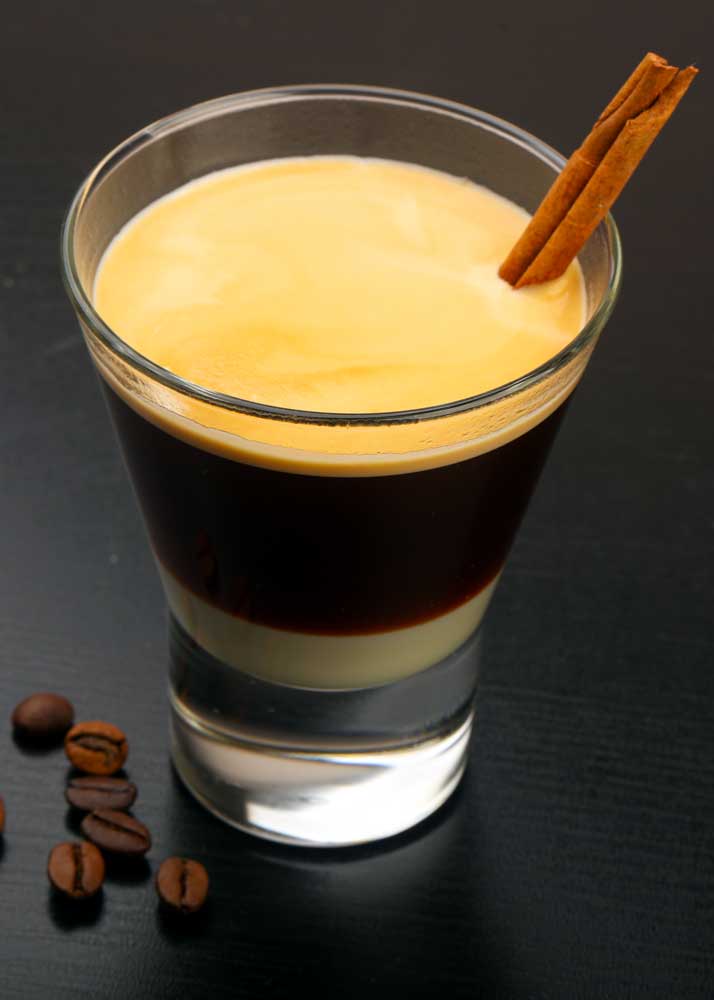
A note about café manchado. Literally, this means stained coffee. The meaning will change depending on where you’re visiting.
If in doubt, ask about the ratio. Or be adventurous and order it everywhere you go and see what you’ll get.
- Sometimes this refers to cortado (espresso macchiato) which is coffee-stained with milk.
- Other times this refers to leche manchada, which is milk stained with coffee – the opposite mixture.
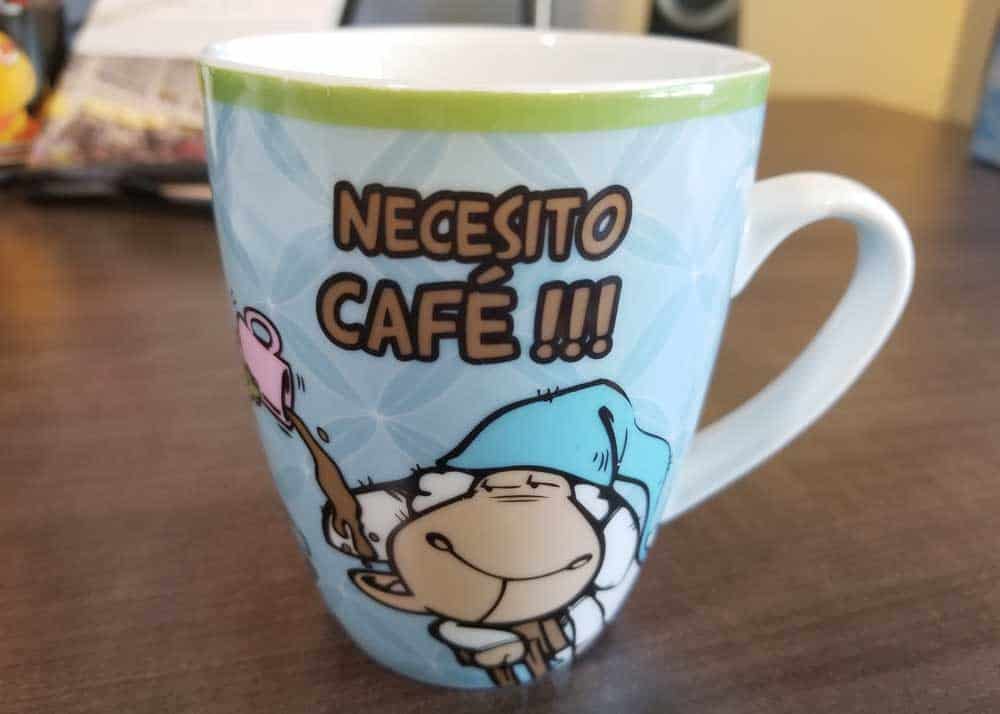
Vocabulary for Ordering Coffee in Spanish
- Para llevar: to take away
- Taza: mug with a handle
- Caliente: hot
- Demasiado caliente: too hot
- Templado / Tibio: lukewarm
- Fría: cold
- Azúcar: sugar
- Hielo: Ice
- Sacarina: sweetener
- Leche: Milk
- Canela: Cinnamon
Learn how to order a coffee in Spanish (Video)
Prefer watching and listening? Here’s a great summary to help with pronunciation and vocabulary.

More reading: 79 Types of Coffee (Definitive Guide)
Get the cheat sheet: How to Order Coffee in Spanish: Cheat Sheet. It’s downloadable (and printable). And will put all these phrases in your pocket.
Your Turn
How did you make out? Did I miss something? Let me know in the comments!
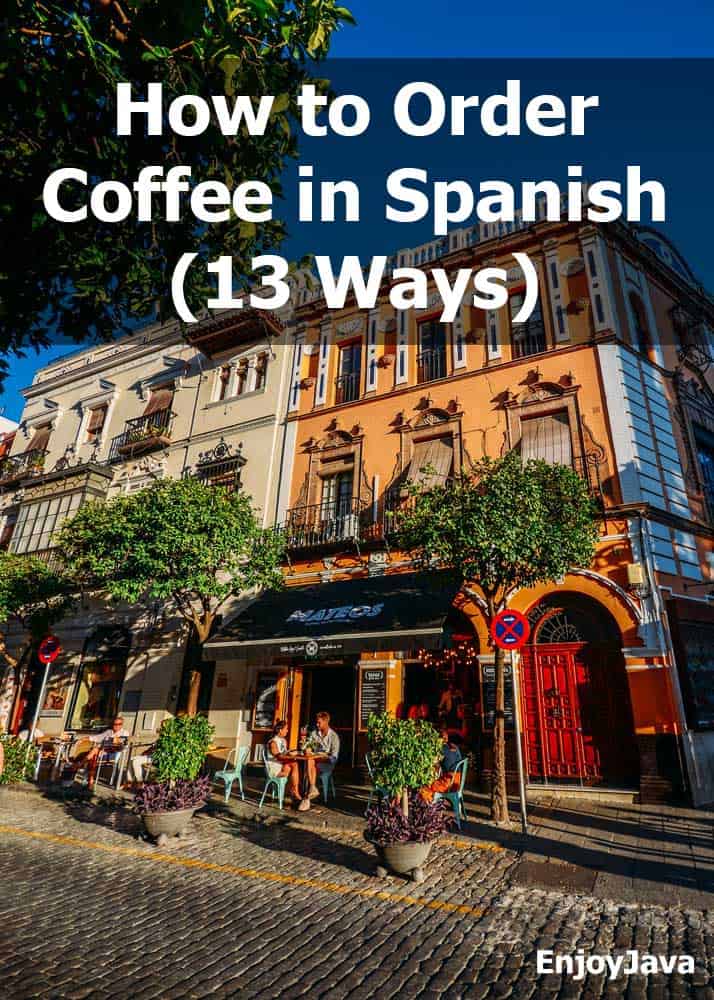
Planning on doing more travel? Here’s how to order coffee in French.
- About the Author
- Latest Posts
Bryan Haines is a co-founder and writer on EnjoyJava – and is working to make it the best coffee blog in the world.
He is a travel blogger at Storyteller Travel and blogs about photography at Storyteller Tech. He is also co-founder of Storyteller Media, a company he started with his wife, Dena.

Traci
Friday 5th of May 2023
How would you order a coffee with half and half?
David
Sunday 3rd of October 2021
I love americanos with steamed milk.
Yo voy a querer un cafe americano con.... leche al vapor? o leche humado?
Thank you!
gayzer
Wednesday 1st of September 2021
That are definitely excellent. Many of these tiny details are made getting lot of background knowledge. I am interested in them plenty.